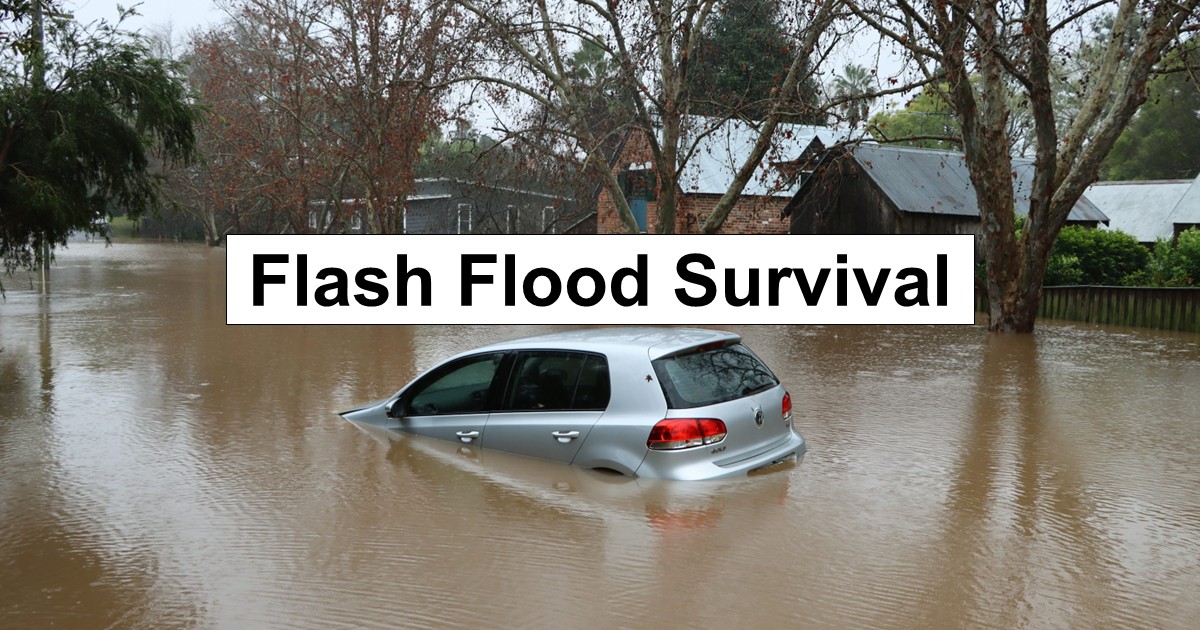A few weeks back, I wrote about the tragic Texas July 4th flash flood that killed over 100 people. That specific disaster got me thinking about flash flood survival because I don’t think I’ve written about it before. Surviving a flash flood isn’t really about what you do when the water is already rushing toward you because, by then, it can be too late.
Flash floods can develop in minutes with little warning, turning peaceful streams and dry beds into raging torrents that will sweep away people, cars and everything else that gets in the way.
I should hope it’s fairly obvious to preppers on how to survive such events, but you never know. So, here’s what to know.
What You Do Before the Flood is Crucial
The most important flash flood survival actions happen when everything looks fine. No doubt, this starts with understanding your risk. If you live in a flood-prone area, you probably already know it. But if you’re not sure, FEMA has tools to check your flood zone, so it’s worth taking a few minutes to understand what that means for your safety.
Next, set up multiple ways to get weather alerts. Your phone should alert you with emergency warnings (check your settings to make sure this is enabled) as I’ve stated in previous posts. To ensure this happens, I recommend downloading a dedicated weather app like NOAA Weather or the Red Cross Emergency app.
Here’s the part most people skip: actually having an evacuation plan should worse come to worst. Where’s the nearest higher ground? What route would you take to get there? What if that route is blocked or inaccessible? Which roads in your area typically flood first? If you’re trapped in your house, is there an upper floor or attic you can reach until help arrives? What about your pets?
It’s these types of questions that, although you don’t need ironed out immediately, are the ones that need asked so that you and your family have at least considered them.
Pack a go bag with basics like water, food, medications, and important documents in case you must evacuate. Keep a smaller emergency kit in your car, too, but check/replace the contents regularly because perishable supplies will go bad rather quickly in extreme temperatures.
The key insight from experts is simple: once you get a flash flood warning, think immediately about getting to higher ground. Don’t wait to see how bad it gets because, as people sometimes find out, by then it can be too late to act.
Granted, we get the occasional flash flood watch or warning where we live, but I never really think about evacuating. Most of these warnings are for low-lying areas, creeks, and whatnot … not for our home.
This brings up an important point: where you are when heeding watches and warnings matters. Clearly, low-lying areas are more likely to flood, so you really need to know where you are.
When It’s Actually Happening: Move Fast!
Once flooding starts, speed is everything. Get to the highest ground you can reach as quickly as possible. If you’re in your house, head to the upper floors. If you’re outside, get to higher ground immediately. And don’t merely assume that because you’re currently safe at the nearest higher ground that things can’t get worse, because they can.
Equally important: never try to walk, swim, or drive through floodwater. It only takes six inches of moving water to knock you down, and one to two feet can push a car around like a toy. Even that big SUV won’t help you. Here’s a demonstration of what to do should you find yourself trapped in a vehicle:
If you do get trapped in a vehicle that’s taking on water, you need to act fast. The key points are to unbuckle your seatbelt immediately, break the window (aim for the corners, which are weakest), and get out before the car becomes fully submerged. Having a car escape tool that can cut seatbelts and break windows is smart planning. Even better? Consider securing it to your seatbelt or other easily accessible location in your vehicle so that it’s always where you need it.
If you end up in the water, try to float on your back with your feet pointing downstream to absorb impacts from debris, rocks, and who knows what else. Look for anything solid you can grab onto and climb up because it’s possible that things will only get worse as things continue.
The National Weather Service puts it perfectly: “Turn around, don’t drown.” If you see a flooded road, turn your vehicle around and find another route.
The Bottom Line
Flash flood survival comes down to preparation and quick action when warnings are issued. Most people who die in flash floods either didn’t get the warning, ignored it, or tried to drive through water they thought they could handle.
Your smartphone can be a lifesaver if you set it up right. An evacuation plan can save your life if you only make one. And your willingness to take warnings seriously and move to higher ground immediately can mean the difference between a scary story you tell your buddies over a beer … and a tragedy your buddies tell about you over beers.

Leave a Reply